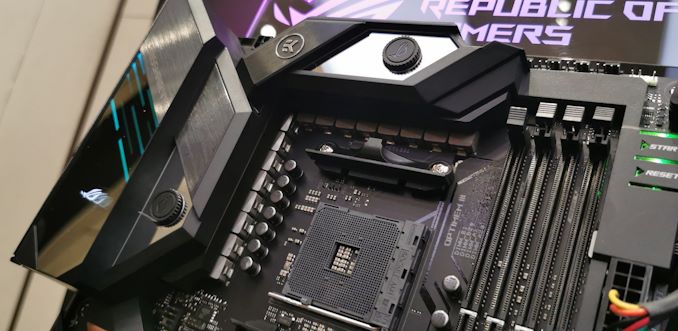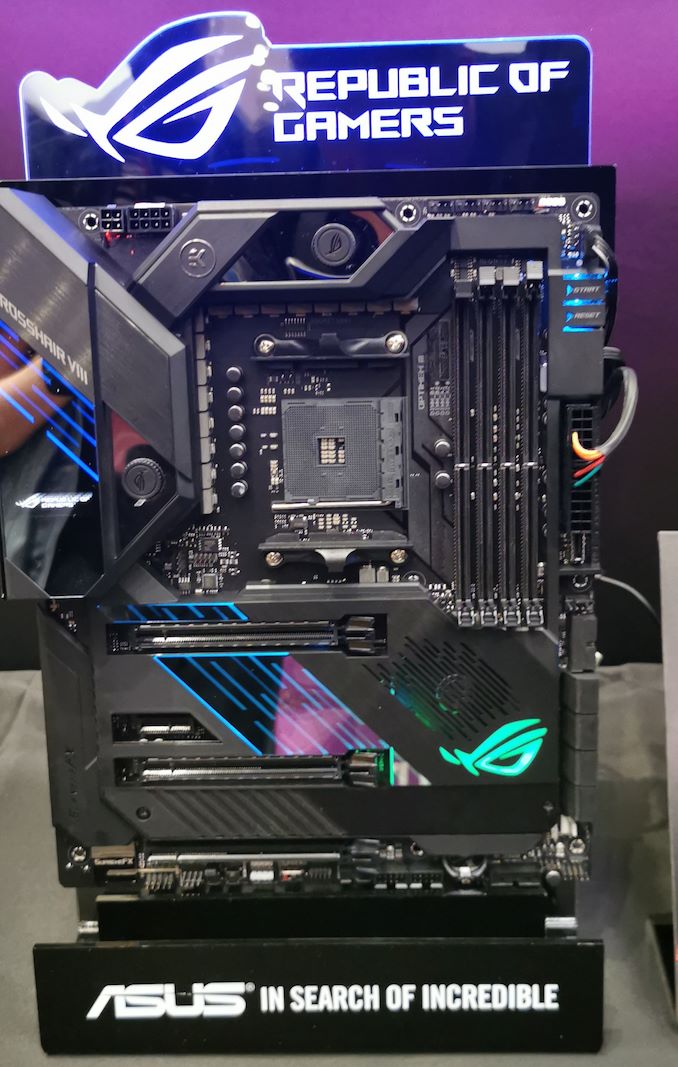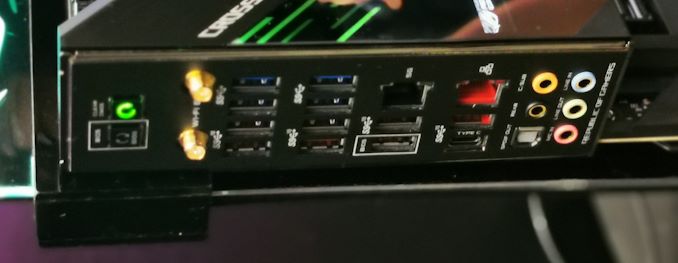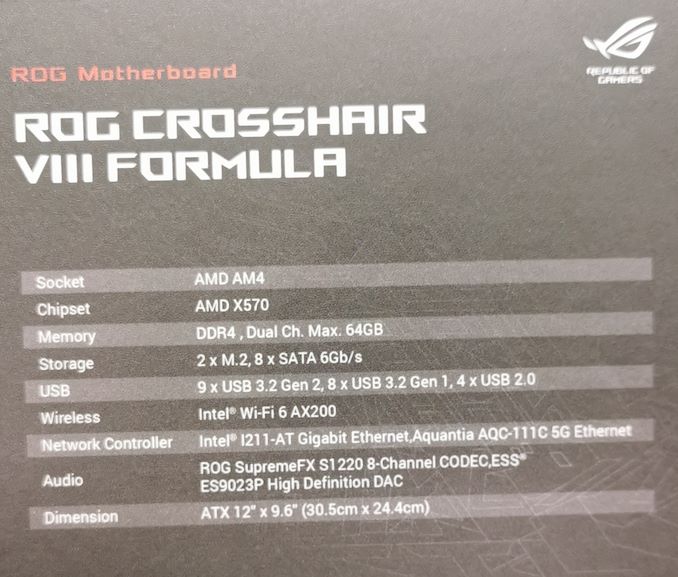ASUS Announces its X570 Flagship Motherboard, the Crosshair VIII Formula
by Gavin Bonshor on May 28, 2019 12:00 PM EST
During Computex 2019, ASUS has unveiled a series of new AM4 motherboards designed for the impending Ryzen 3000 series processors. The top tier X570 Crosshair VIII Formula model features dual PCIe 4.0 M.2, Aquantia AQC111 5 GbE, as well as the new Intel AX200 Wi-Fi 6 interface for cutting edge network connectivity.
The ASUS ROG X570 Crosshair VIII Formula represents its high-end X570 entry onto the market with some very notable features, including a revamped design with a strong focus on performance, and ROG themed aesthetics. First of all, the ROG Crosshair VIII Formula uses EKWB heatsinks which can be connected to a custom water cooling loop for better power delivery temperatures, or as passive cooled. This has been seen on numerous iterations of its Maximus Formula boards created for Intel chipsets. This marks a shifting tide where ASUS seem to have confidence in AMD and the ability of its 7nm Ryzen 3000 processors, by opting for such a premium model for the X570 chipset. Also featured are a LiveDash OLED screen, a full metal backplate for a more rigid frame, and ROG armor across the majority of the PCB; not to forget about the swathe of RGB LED zones and the integrated fan within the chipset heatsink.

(apologies for the image quality, it was a busy post-presentation melee to get photos. Will try and get better ones at the booth later this week.)
One of the main focal points of the X570 chipset is its native PCIe 4.0 support. The ASUS ROG Crosshair VIII Formula has three-full length PCIe 4.0 slots operating at x16, x8/x8, and x8/x8/x4, with the final x4 coming from the chipset. This allows users to use two-way NVIDIA SLI and two-way AMD Crossfire multi-graphics card configurations. For add-on cards, a single PCIe 4.0 x1 slot is also present. There are also four DDR4 memory slots with a maximum supported capacity of up to 128 GB.
On the componentry, the Crosshair VIII Formula uses a premium controller set with the most notable inclusions coming on the networking side. An Aquantia AQC111 5 GbE controller with a secondary Intel I211AT gigabit chip offers users dual LAN, but more impressively, ASUS has jumped onto the Wi-Fi 6 bandwagon by including the new Intel AX200 2x2 Wi-Fi adapter. The onboard audio is controlled by the Realtek SupremeFX S1220 HD audio codec. On the rear panel is a wide array of connections including seven USB 3.1 G2 Type-A, one USB 3.1 G2 Type-C, and four USB 3.1 G1 Type-A ports. Users can add to this with one USB 3.1 G2, two USB 3.1 G1 and two USB 2.0 front panel headers, with the USB 3.1 G2 offering one additional port, and the rest each offering an additional two ports per header.
Pricing and availability are currently unknown at present, but it is likely that the ROG Crosshair VIII Formula, along with its other X570 models will be available prior to the launch of the AMD Ryzen 3000 series processors on 7/7.
| Want to keep up to date with all of our Computex 2019 Coverage? | ||||||
 Laptops |
 Hardware |
 Chips |
||||
| Follow AnandTech's breaking news here! | ||||||












21 Comments
View All Comments
chada - Tuesday, May 28, 2019 - link
I think you mean VIIIHifihedgehog - Tuesday, May 28, 2019 - link
This. It's a superb article. Just a teeny typo is all. :)martinbrice - Tuesday, May 28, 2019 - link
Sooooooo close. That 5G ethernet needed to be 10G....then I'd buy it. Now I'm trying to decide if I should consider that MSI MEG (hate the style), or just wait for Threadripper 3.r3loaded - Tuesday, May 28, 2019 - link
Yes, for a flagship it really should come with 10G ethernet. I also wonder why these boards only come with a dozen USB-A ports but only one USB-C port considering that the latter is the future.Hifihedgehog - Tuesday, May 28, 2019 - link
> the latter is the future.Too many devices are still USB-A terminated and decades of them that need it are. The future is still largely in the protocol, not necessarily the port.
rahvin - Tuesday, May 28, 2019 - link
USB 3.1 is backwards compatible. You can't still have all those USB-2 devices on higher ports. It doesn't make any sense for them to still be including a bunch of USB 2 ports, everything should be USB 3.1 at this point maybe a couple 3.0 ports. You can still support USB 3.1 while being a Type A port.Including only a single USB-C port at this time is just nuts, these boards will likely be in computers for 10 years and by that point almost everything will be Type-C. Just like every other USB platform it takes about 10 years from introduction to domination and USB-C is still in the middle of that timeframe, but give it another 5 years and almost everything will be Type-C at that point with probably only keyboards and mice still on USB2 (but even those will shift at some point).
It's just beyond foolish for them not to be including more USB gen 3.1 or 3.2 at this point.
CaptainBooboo - Wednesday, May 29, 2019 - link
USB-2 ports still exist for two reasons:1 - Plugging something into USB-3 takes up more PCI-E lanes than USB-2, even if the devices connected to it don't need the bandwidth (keyboard, mouse, etc.). Connecting those devices to USB-2 ports instead leaves the PCI-E lanes open for the computer to use on other things.
2 - USB-2 devices with USB-2 drivers (installation media, for example) can have issues when plugged into a USB-3 port, despite the backwards compatibility.
risa2000 - Tuesday, May 28, 2019 - link
USB-A ports are (at least from my experience) far more solid and robust when connecting thick USB cables than USB-C port. USB-C is good for portable devices or something you disconnect/reconnect more often, but for this purpose it is far better to have those ports on the front panel and not on the motherboard backplate.mooninite - Tuesday, May 28, 2019 - link
Agreed... a 2019/2020 flagship mobo needs 10G ethernet, but hey this is a great start. I think this is the first consumer-level mobo with onboard >1G ethernet ports. Finally!alufan - Tuesday, May 28, 2019 - link
hmm 10G really and who has 10G to use so why is it essential,